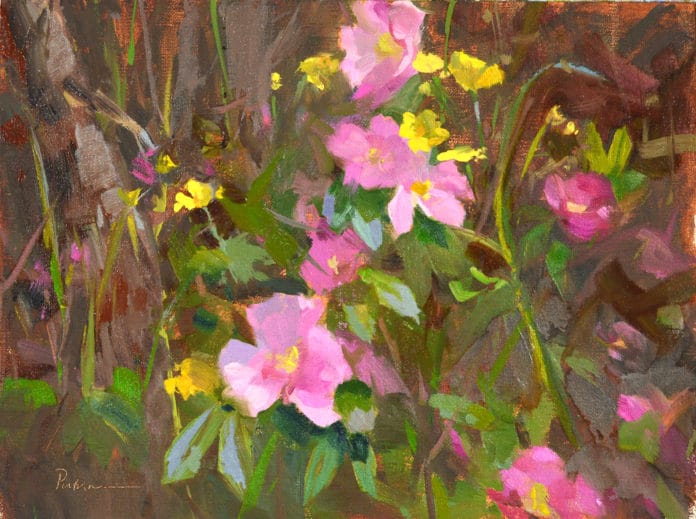
By Lori Putnam
Just as individual as our personality, so is the vision of an artist. It is one of the reasons that a dozen of us can go out and paint in the same location, and every painting will be vastly different. Some artists are interested in painting only specific subject matter, such as landscapes, portraits, or architecture. Others are only excited about painting strong light and shadow. For me, it is my fascination with rhythms and patterns that really gets the creative juices flowing. What interests me is rarely any specific subject. Scenes in our everyday lives are overflowing with rhythms, patterns, and connected shapes, and I have been noticing them all my life.
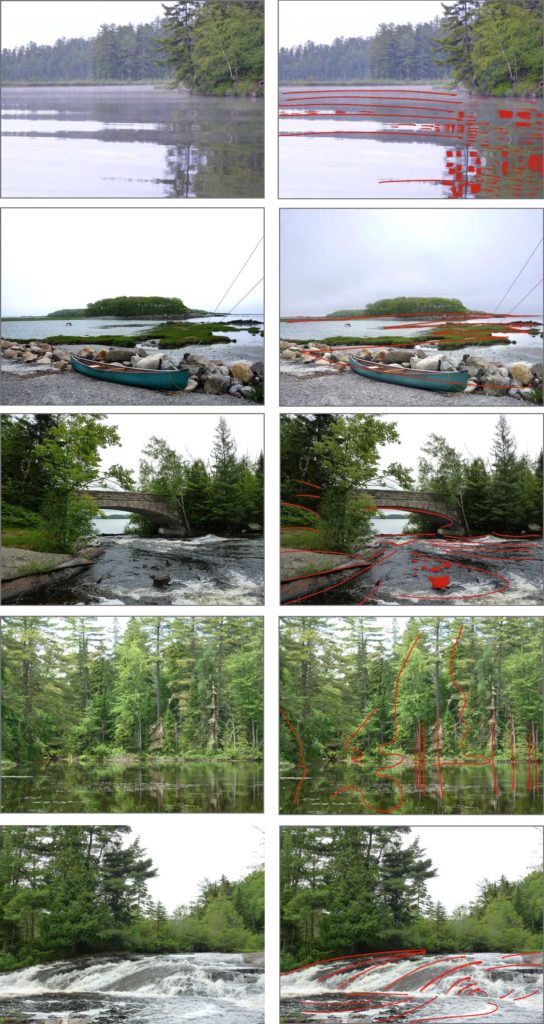
The easiest rhythms to recognize are scenes with rolling fields, winding streams, and receding mountains. These examples are practically handed to you on a platter. You immediately get the idea of movement, spatial relationship, and line. This kind of rhythm recognition is only the beginning. The more you observe it, the more micro-rhythms also appear. Subtle shifts in values and colors inside the major shapes are some of the ways nature repeats itself. But in fact, almost everything presents rhythms and patterns once you begin to discover them. Because my work is not subject driven, I also recognize rhythms and patterns in a still life or figure. However, looking back on when this first began, I can see it was nature that taught me.
My earliest memories of this kind of observation began in my early childhood. I grew up in the Tennessee countryside. In Middle Tennessee we are known for our hills, streams, and curvy roads. Riding in the back of our Ford station wagon down the long dusty road to our house felt like a roller coaster. Fun for a kid before the age of seat belts for sure. I remember consciously thinking about how the road and the hills and the creek all criss-crossed and how they formed interesting shapes, each shape growing progressively smaller and smaller in the distance.
As I approached adolescence, I noticed a desire to count. Not in an obsessive way, but in search of patterns. Probably at first it was looking at patterns in our bathroom tile. I remember trying to decide if the tile repeated squares or triangles. If only I had known about Escher, I would have realized it was both. Next, I recall organizing our cabinetry into sets of doors, drawers, and pulls. Not only did I think about these as sets, I looked for the way they flowed and created rhythm to carry your gaze across the kitchen, skipping from one cabinet handle to the next in a sort of staccato fashion until my pattern stopped dead still at the refrigerator.
Traffic lights are also an example of my counting shapes and putting them into sets. I cannot tell you how many traffic lights I pass as I am driving. What I can tell you is if the one at which I may be sitting currently has a pattern of 2 or 3. Meaning the number of lights is divisible by either 2 or 3. Now, this may seem really odd if you are not a pattern counter. And in fact, many people suffer from Arithmomania (a mental disorder associated with obsessive-compulsive disorder). But in this case, the counting has nothing to do how many of something there is or how many times you must do something (like wash your hands). It is not about special numbers or keeping a tally. Telephone poles and picket fences can go on and on. I do not have to find the last one or count all of them. It is about observing patterns and spatial relationships. And I believe my early discovery of this is why I am in tune to rhythms and patterns around me.
I cannot talk about all of this without at least mentioning fractals. If you know anything about them, you understand that these infinitely complex patterns occur all over the natural world, from seashells to galaxies and all of the river systems and growth spirals in between. Why is this important to me? Well for one, it is reassuring that I do not need a finite number to feel safe. Instead, I celebrate the vastness of it all. Fractals are less about mathematics to me and more about design. It is not only the pattern of objects, but the spaces between them and the visual relationship they have to each other. Most importantly, it feeds my fascination.
The third phenomenon of which I became aware was seeing human characteristics in other objects. Faces are everywhere! Part of this is just because as humans we identify with faces. A lot of people see them. People generally prefer faces to patterns. We anthropomorphize faces in cars, houses, and buildings. An easy one, two fried eggs and a slice of bacon on a round plate. The front of a VW Beetle is another. Remember the woman who found the Virgin Mary’s face on her burnt toast? Here in Nashville, we were home to the Mother Teresa cinnamon bun. Back to my tile floor: It was not just counting and organizing tiles. It is the natural streak in the marble with subtle shifts in tone . . . and my bathroom is suddenly very crowded with people. Seeing faces in bathroom tile seems to help my brain tap into my creativity. Recently I took my easel in and painted a little sketch of this guy.
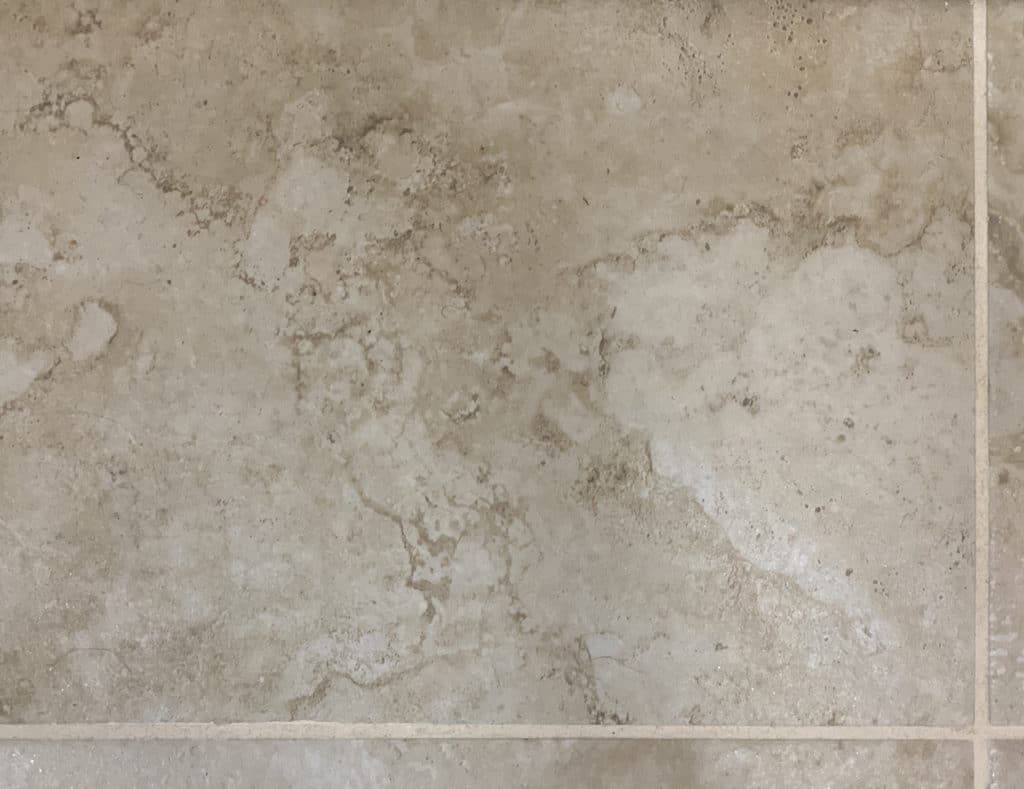
In my case, a human face is made up of patterns. This is known as pareidolia and is particularly linked to assigning facial features to otherwise random patterns, and vice versa. See where I am going here?
The real challenge for an artist, however, is knowing when to emphasize the pattern or rhythm, and when to break it. By emphasizing, we get one result. In this painting, “Approaching Altitude,” the rhythm has been emphasized. I have made sure to join every shadow shape to enforce the receding picture plane, and lead you on a journey miles and miles through the scene.
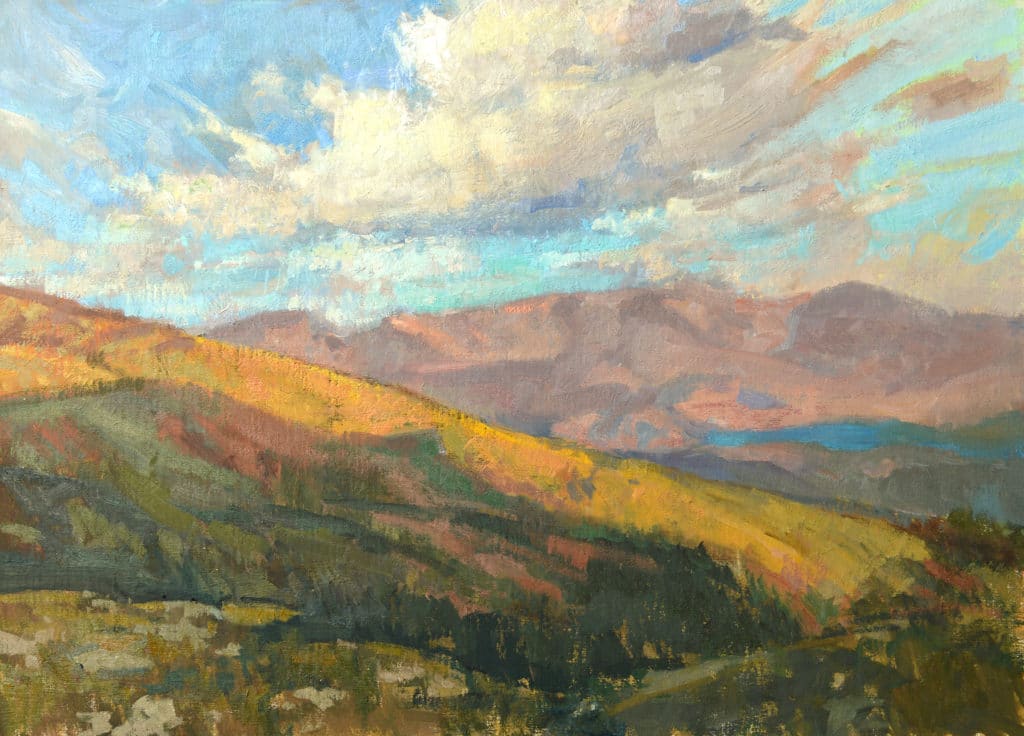
Now take a look at “Snow Mass” (below). Here I have intentionally broken the pattern in my design by adding the dark mass of a cedar tree in the background (upper right). This creates tension, and has a similar effect as the refrigerator in our kitchen scene. Only this time, the stop is caused by a significant change of value. By either emphasizing or breaking rhythms and patterns, I can paint two distinctly different paintings. Each one tells a different story.
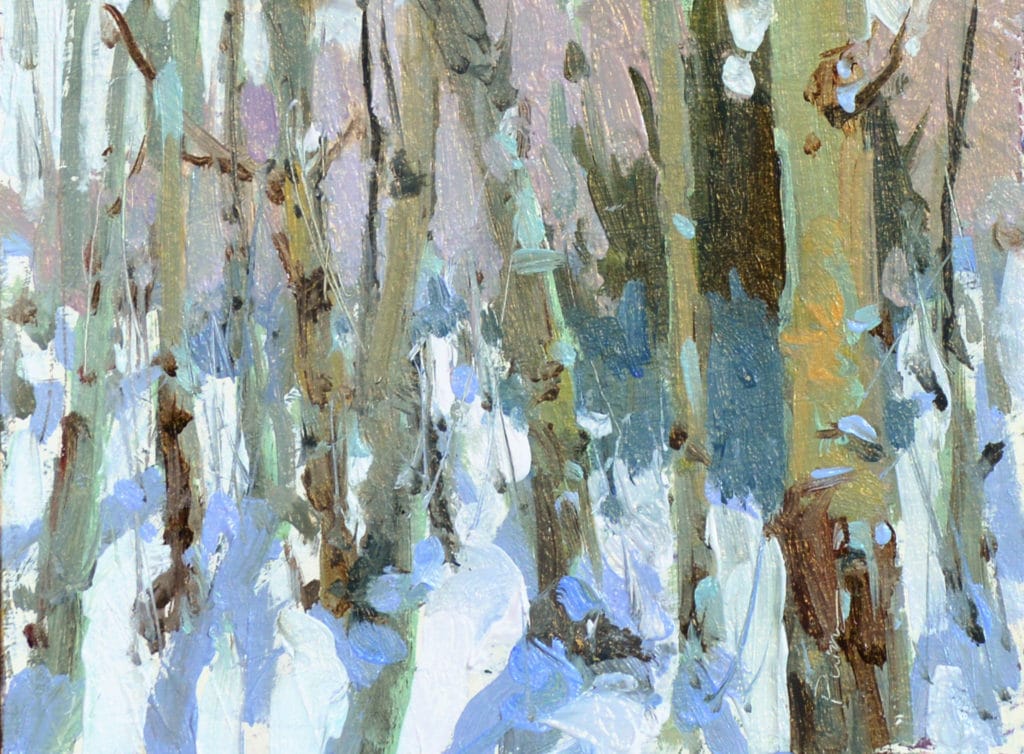
The next layer of complexity to take into account is the way humans see. We have weak peripheral vision, and our eyes are always trying to track or focus on something. Imagine looking out of the back window of your Ford station wagon like I did as a little girl. If you look slightly forward and focus on one tree, you can follow it as it seems to pass, by turning your head. But if you look directly out of the window, you cannot focus on anything. Your eyes are constantly trying to track, to find one tree, and become exhausted quickly. You may even feel a bit queasy. We only see clearly when we look straight ahead. When the object we are trying to see does not appear constant, our brain cannot select specific information. Summers in Tennessee are hot, humid, and absent of rain. Imagine watching those tree trunks weave in and out, masked by the dust patterns of some vehicle that had been in front of ours several miles before. I had no idea that this way of seeing and brain processing was preparing me for my future as an artist.
In these two paintings of cows, the first is indicative of what we see if we focus on just one cow as it approaches and we continue to follow it with our eyes, turning our head as we drive by. The second is what we see if we try to focus straight out of the window. These two ideas are represented differently. The better use is dependent on the message I want to send.
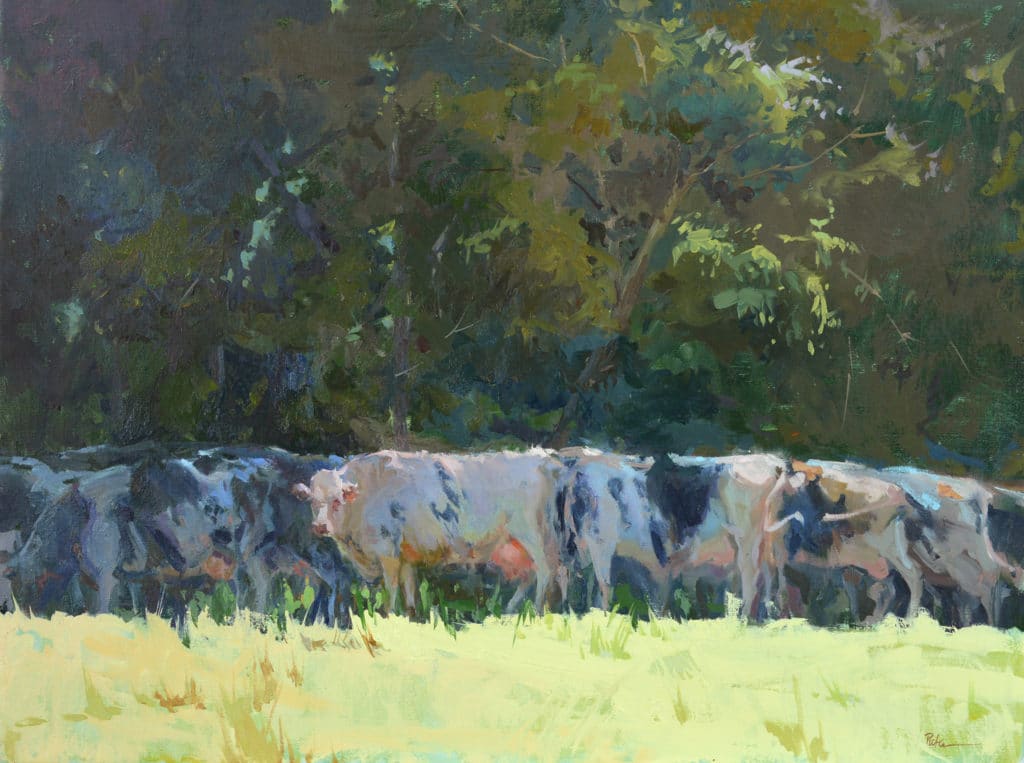
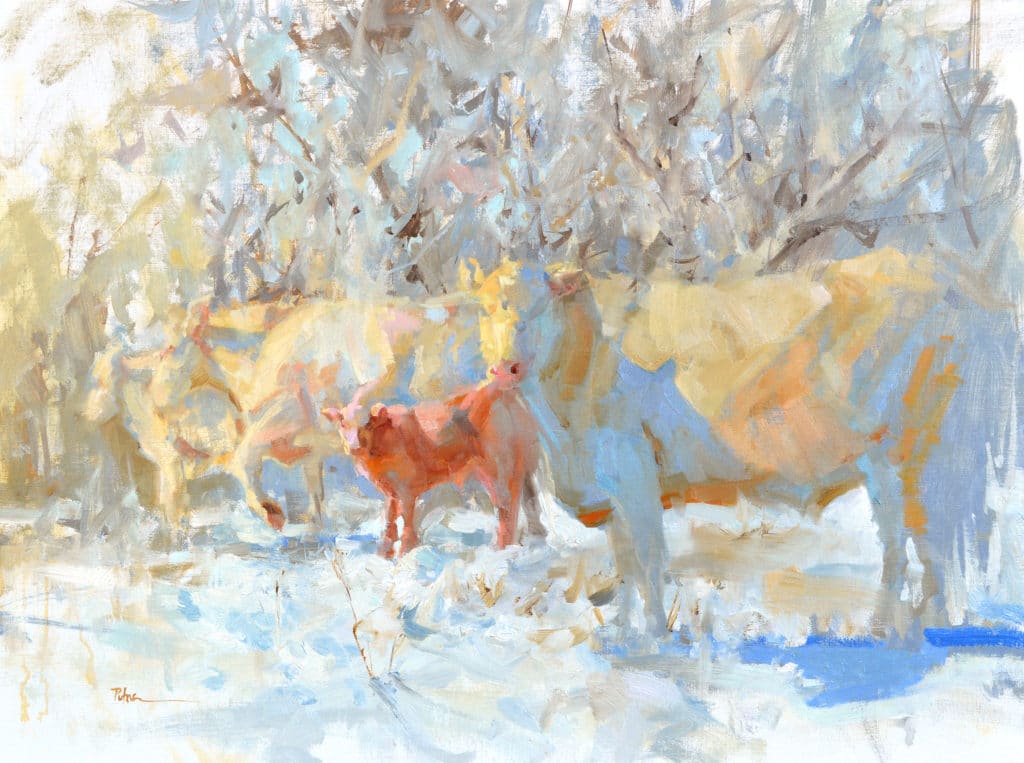
Our brains, trying to be as efficient as possible, only detect “change.” Not the fastest processor on the market, the brain can only receive three “images” every second. After sorting and combining those images with the ones received previously, the result is what you experience as “seeing.” Think back on the trees as you look straight out of the car window. You see no contrast, no hard edges, everything blurs together. Try this for 30 seconds, then look straight ahead again. Because your brain has adapted to the movement, even those trees that you could focus on before will seem to be flying at you.
Click here to view a GIF that will make this easier to understand. Try to focus on the center of the spiral for 30 seconds. Then glance away. For just a few seconds, the object around you will seem to warp and move.
What does all of this have to do with painting? Fast forward many years and over a million miles of travel later, and what has developed is a way of viewing that in no way suggests there is any subject at all. There really should be another word for this. It is not something I am actively doing so much as it is something my creative muscles are receiving. It is more like informed chaos, or excessive lucidity than it is seeing. There is no escaping it, and I would never want to. My job is to create illusions. I must use every visual mechanism I can to turn viewers of my work into believers of my message. They must suspend disbelief. The first order of business is getting them to trust that there is a three-dimensional scene or object on this two-dimensional surface. That is the simplest task and one that most anyone can learn to do. Because I am attracted to pattern, I have used it here to suggest a flock sheep. My secondary tools are perspective, form, line, shape, and varied edge.
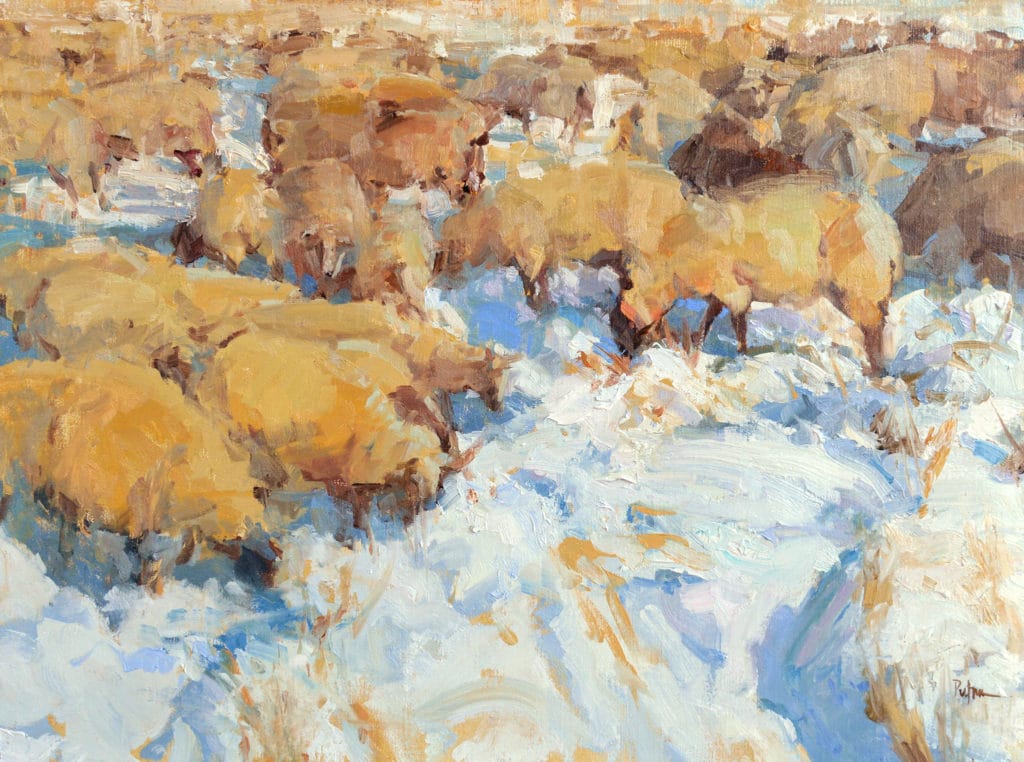
Another undertaking may be to persuade the viewer to travel around the canvas. The more I can keep someone’s attention, the better I have performed my duty. Remember that our brains only detect change. Tools useful for sending our brains a message could be hard edge, line, rhythm, color, and value (specifically contrast). Contrast and color are great attention getters. To keep someone’s attention, however, depends on the number of other elements the person needs to process. If we use too many, the brain gets overtaxed and the person walks away. I try not to exhaust all of my options on the same canvas.
Here the color and contrast in “Fall at Dry Fork Creek” take you right to the good stuff, that hillside just turning colors in the fall. If you look closely, you also begin to notice line, rhythm, and varied edge. These elements are the supporting cast.
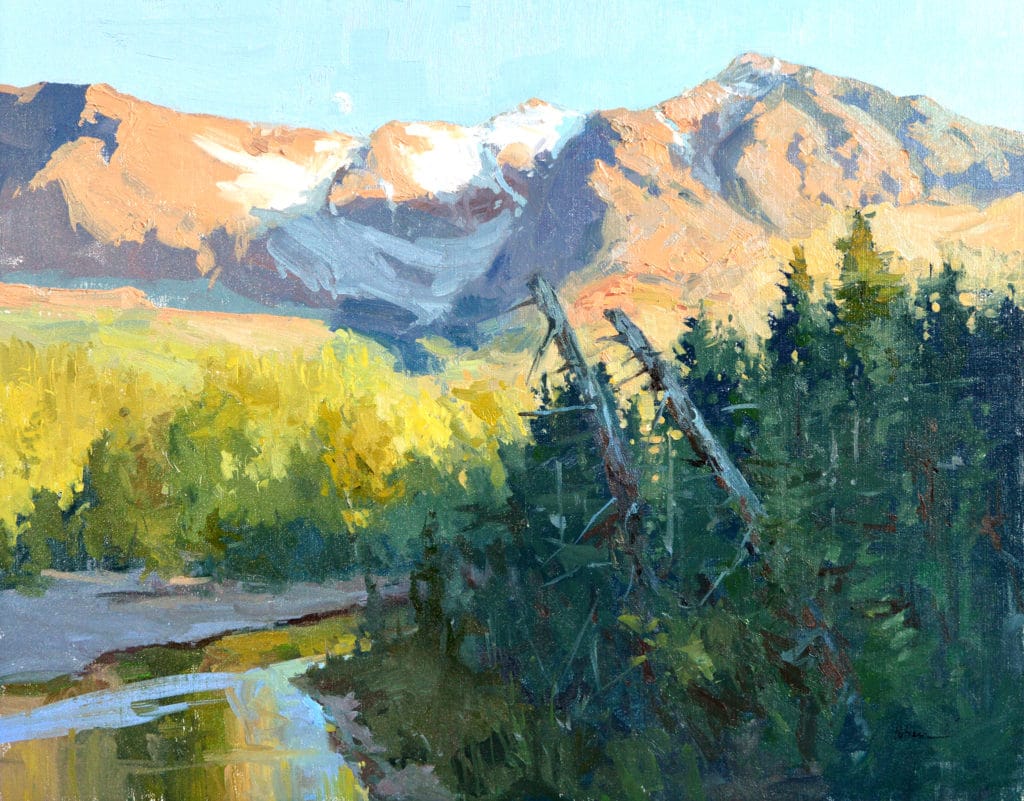
See how the rhythm of the wild country rose in this piece mimics the rhythm in music? That is exactly what I thought as I was designing it. There were many more flowers and dashes of color that I eliminated. They would have distracted from the feel I was trying to capture.
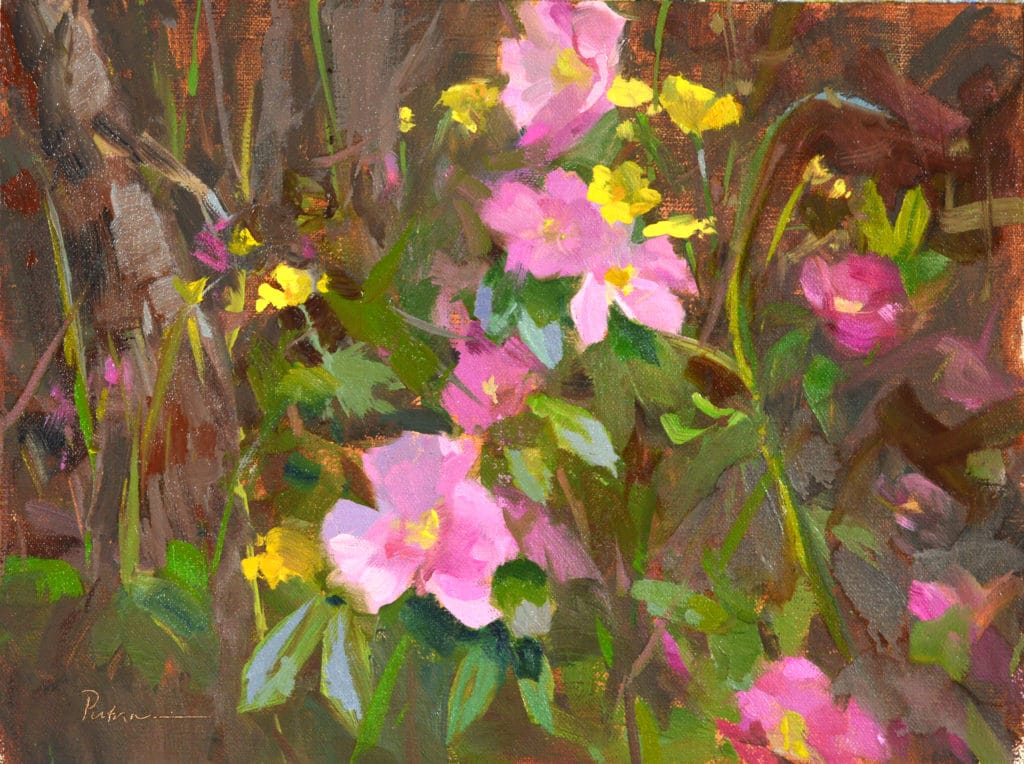
Now, let’s say I want to give the impression of movement. By studying fractals and experimenting with moving illusions such as the GIF, I can use design, pattern, and edge to help water move, boats rock, and birds fly.

The more artistic devices I can understand, the more choices I have in using them. My loyal fascination with rhythm and pattern can be made stronger by partnering with these resourceful tools. There are infinite combinations. As I mentioned, this is without any regard to subject matter. Although it is easiest to recognize in nature, you can see I have used it here for this interior painting as well. In addition to pattern, I have used a variety of edges to direct your eye.
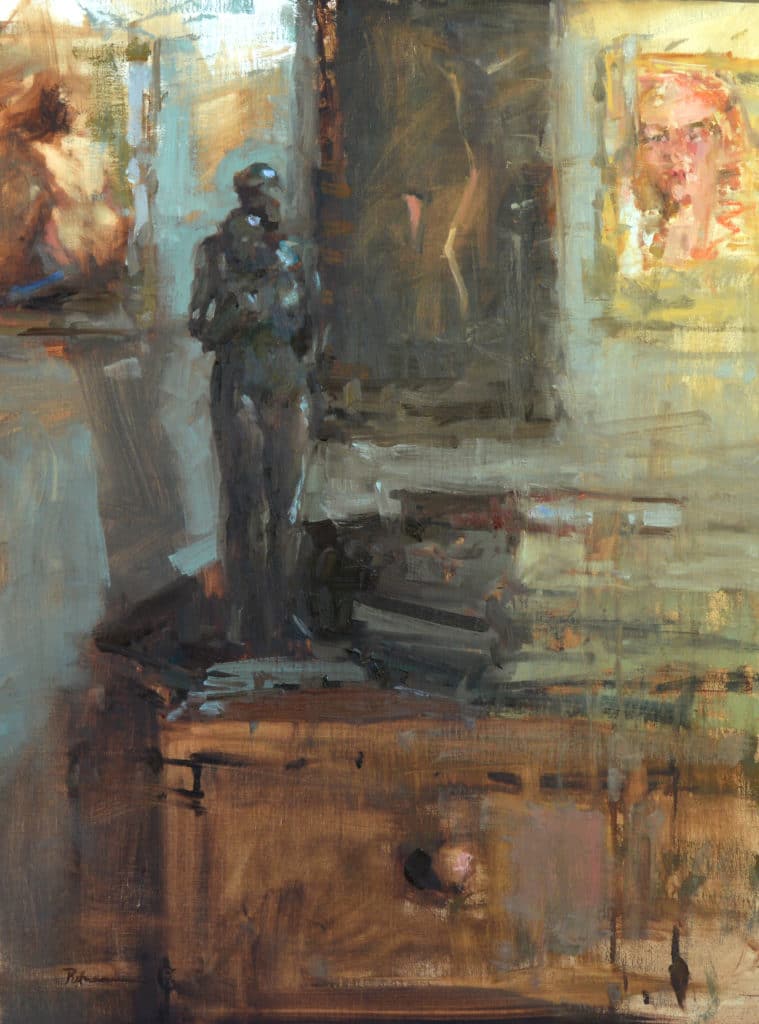
Take a look at this still life. By arranging the flower pattern into sets, saturating their color, and neutralizing it elsewhere, you feel the weight of the bending stems even though they are tucked down deep where you do not even see them. Keeping details and edges on the ceramic pot and vase to a minimum help as well.
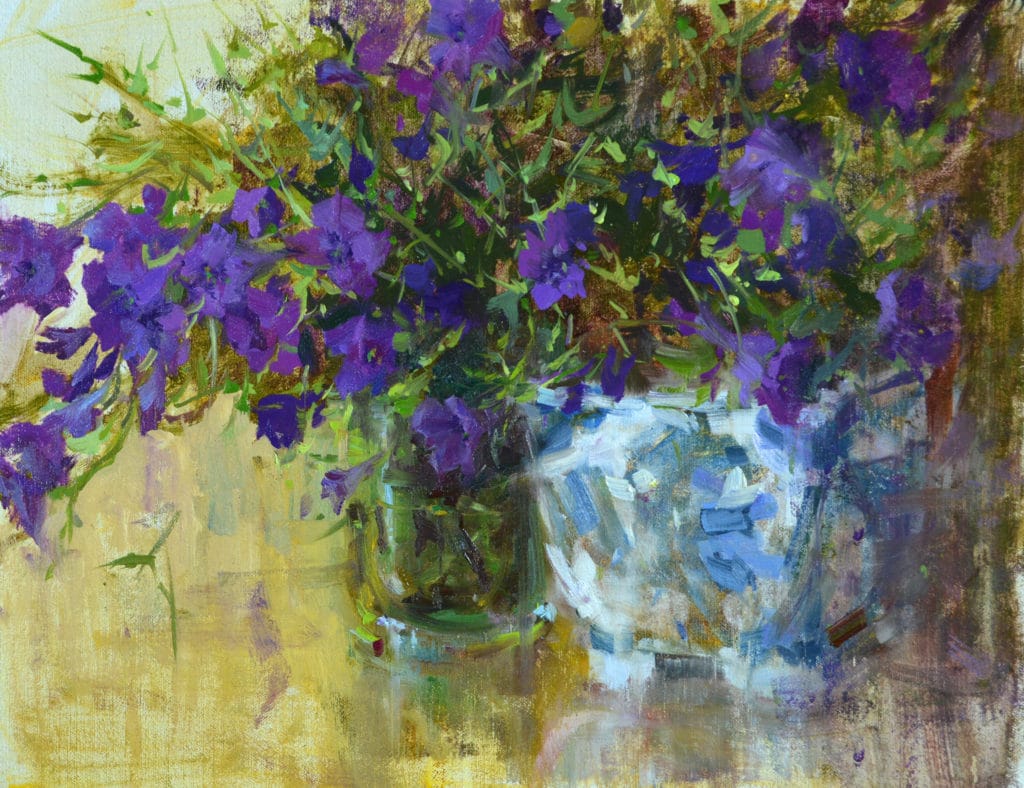
A little more difficult to describe is how to see rhythm and pattern in the human face. Drawing instructors use whatever means they have found works for them to teach others. Some say faces are round; others use a box; still others fit everything in an envelope. But no matter what the subject is, I see triangle patterns. For me this is particularly helpful in painting a portrait. I recognize not only the triangle between the corners of the eye to under the nose, but others as well. The cheeks, temple, center forehead, jaw, ears, neck, mouth, all of the shapes are simply different types of triangles.
Do you consciously incorporate rhythms and patterns into your paintings? If so, how? Tell us about it in the comments section below!
About the Artist: 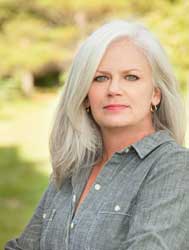
Lori Putnam (b. 1962) began painting professionally in her mid-30s. The feel of the paint immediately ignited her love affair with the medium, and she knew there was no turning back. No stranger to hard work and dedication, she quickly gained recognition as one of the top living American Impressionists. When viewed in a photograph, her work may appear tightly rendered. But upon seeing it in person, viewers are instantly engaged by thick, expressive paint. About her own work she says, “What interests me is rarely any specific subject. Like a magnet, I am immediately attracted to nature’s harmonies, rhythms, and patterns. My work invites viewers to explore and follow clues as if to a mystery. They become artists themselves for a brief moment, but will continue to see the world differently from that moment on. This is my passion, my drive, and my reward for the work.”
Putnam has been featured in numerous issues of Western Art Collector, American Art Collector, Plein Air, Southwest Art, Fine Art Connoisseur, and Art of the West. She is a member of many respected organizations including the Salmagundi Club in New York City, the Oil Painters of America, the Portrait Society of America, the American Impressionist Society, and the California Art Club. In 2018 she accepted an appointment to the board of Art Ambassador for a Colorful World and travels to work with children in less-fortunate countries across the world.
Museums, including the Tucson Museum of Art; the Brinton Museum in Big Horn, Wyoming; the Hockaday Museum of Art in Kalispell, Montana; the High Museum in Atlanta, Georgia; the Irvine Museum in California; and the Academy Art Museum in Easton, Maryland, have sought out Putnam’s works for awards, exhibitions, and permanent collection.
She maintains a studio in Charlotte, Tennessee.
http://loriputnam.com
Follow: @loriputnamart

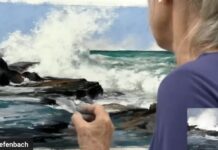


Oh My Goodness, Lori! When I got to the part about the tiles in the bathroom, I had to read a sentence or two to Haywood. When I am in my bathroom, I see faces and figures in almost all of my marble tiles! Sometimes it actually drives me crazy! But, I do love it. Many of your ideas are things I do, but you have put them into such a great article and have told me why I am doing this. I use the word anthropomorphize … when I can actually “say” it correctly. I have many times named my paintings with something that is based on being human … one comes to mind called “Three Sisters.” This was a group of trees and you could just see one was telling a story and using her hands, one was laughing almost uncontrollably leaning backward, and the other with hand on hip was amazed! You also have taught me a new word, pareidolia. Now I have to go look it up and learn about this word! Love it Lori… Thank you so much.
Oops… wrong title I gave. It was “Three Ladies” …. I do have another called “Three Sisters,” though.
Lori, thank you for an incredibly informative and inspiring article. I would love to hang out with you and soak up some of this knowledge that you have such a wealth of!
Lori,
What a great article! Not only does your art INSPIRE us, but you really have a talent for being able to articulate your thoughts! Along with Marsha, I too see faces and animals in my bathroom marble floor. So glad to know that I am not the only one! Ha! Thanks so much for sharing Lori!!!
This was an awesome article. Yes, I can relate so well, but did not really know what words to put to it. You write beautifully as well. You gave me pause now to ask myself, why am I attracted to what is it I’m seeing. I love to photograph as well, and as I look back at the photo to see why I took that shot, I see great patterns that lead my eye around yet bring it back, just like you said. In painting, I’m finally learning to make a painting verses attempting to copy what I see. I love that you shared this clarity of vision. Thank you thank you thank you. (ha, guess I do like patterns and 3s, funny, I always type ha ha ha as well. Interesting…) oh, and yes, I see faces in tile, then I try to find them again later and often can not. ha ha ha.
I completely agree! Great comment!
This is an incredible article and gives such insight to your painting technique, thought process and how you see and approach your paintings. Thank you for putting this in writing! It will help me approach landscape and plein air painting with a new focused and fresh view.
Not only are these works amazing but your thought processes and ability to describe are brilliant!
Glad to know I’m not the only nutty one who obsesses over pattern, light and describing space–seems like a common affliction/attribution of all who responded. Thanks for sharing your wisdom.
Thank you, thank you Lori for this very informative article. Rhythm and pattern are the cues I needed to help me with the painting on my easel……I’m going to treasure this article with your valuable insights! And thank you Outdoor Painter for your timely, for me, publishing.
Thank you, thank you Lori sharing your perspective on rhythm and pattern in this very useful and informative article. You have so clearly and intricately explained your process. Rhythm and the pattern of light are the cues I needed to help me with the painting currently on my easel……I’m going to treasure this article with your valuable insights! Thank you Outdoor Painter for publishing it now! And thank you to my inner guidance that led me to your wisdom this morning! I, too, am always counting the arrangements of tiles and trees but you have explained the significance of looking and seeing in a new way to me. Now instead of dreading going to the easel….I am anxious to paint today because now I will Look at my painting with a fresh viewpoint.
Such thought went into this article and how well you explain your way(s) of seeing! Thank you!
Your article was so interesting and I, too, see many “things” that will now influence my painting. Thank you so much for sharing your thoughts with us.
Thank you all for reading! I’m so excited to hear your insight as well. Please feel free to share it with others too. Hope to see you all out and about somewhere.
I recognized that face in the tile immediately, have the same tile in my bathroom! Love all of your work here, the cows (I love animals) but that interior still life really called to me! So glad I joined your group recently!
Thank you so much, Lori! I have been seeing faces in the patterns of the bathroom floors & and light reflected from shower curtains for years!! People tell me I’m nuts because they don’t see them, or won’t admit to it. Maybe these faces have been trying to tell me to start painting! I have watercolors & acrylics but fear trying. I am a respected, award wining photographer yearning to paint!